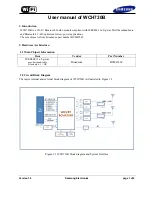
9.5 Restoring Factory Default Configuration
The device has an internal recovery mechanism that allows rolling back the file system to its predefined factory
image or restoring the factory default parameters of the device. The factory image is kept in a separate sector on
the sFLASH in a secure manner and cannot be accessed from the host processor. The following restore modes
are supported:
• None—no factory restore settings
• Enable restore of factory default parameters
• Enable restore of factory image and factory default parameters
The restore process is performed by pulling or forcing SOP[2:0] = 011 pins and toggling the nRESET pin from
low to high.
The process is fail-safe and resumes operation if a power failure occurs before the restore is finished. The
restore process typically takes about 8 seconds, depending on the attributes of the serial Flash vendor.
9.6 Hostless Mode
The SimpleLink™ Wi-Fi
®
CC3135MOD device incorporates a scripting ability that enables offloading of simple
tasks from the host processor. Using simple and conditional scripts, repetitive tasks can be handled internally,
which allows the host processor to remain in a low-power state. In some cases where the scripter is being used
to send packets, it reduces code footprint and memory consumption. The
if-this-then-that
style conditioning can
include anything from GPIO toggling to transmitting packets.
The conditional scripting abilities can be divided into conditions and actions. The conditions define when to
trigger actions. Only one action can be defined per condition, but multiple instances of the same condition may
be used, so in effect multiple actions can be defined for a single condition. In total, 16 condition and action
pairs can be defined. The conditions can be simple, or complex using sub-conditions (using a combinatorial AND
condition between them). The actions are divided into two types, those that can occur during runtime and those
that can occur only during the initialization phase.
The following actions can only be performed when triggered by the pre-initialization condition:
• Set roles AP, station, P2P, and Tag modes
• Delete all stored profiles
• Set connection policy
• Hardware GPIO indication allows an I/O to be driven directly from the WLAN core hardware to indicate
internal signaling
The following actions may be activated during runtime:
• Send transceiver packet
• Send UDP packet
• Send TCP packet
• Increment counter increments one of the user counters by 1
• Set counter allows setting a specific value to a counter
• Timer control
• Set GPIO allows GPIO output from the device using the internal networking core
• Enter Hibernate state
SWRS225D – FEBRUARY 2019 – REVISED MAY 2021
38
Copyright © 2021 Texas Instruments Incorporated
















































